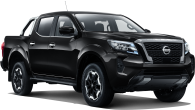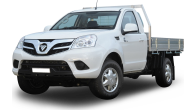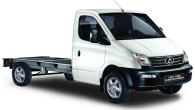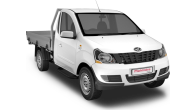Australians don’t normally associate utes with Korea given that its most prominent automotive brands, Hyundai and Kia, do not offer such a popular vehicle. There is, however, another Korean brand - SsangYong – which for many years has flown beneath the radar in Australia yet offers a dual-cab ute.
SsangYong’s origins can be traced back to the earliest days of the Korean car industry in the 1950s. After numerous attempts to gain a foothold here through independent distributors, in 2018 it chose Australia to be its first export market operating under direct factory control of import and distribution. As a result it has established 36 dealerships nationally with a target of 50 by the end of 2019.
And along with razor-sharp pricing, SsangYong is also offering a seven-year/unlimited km warranty. So given this unprecedented commitment to the Australian market and the impending arrival of a long wheelbase Musso ute stablemate, we thought it timely to spend a week in its current premium dual-cab offering to see if it can lay a glove on Australia’s top selling utes.
Ssangyong Musso 2019: Ultimate
| Engine Type | Diesel Turbo 4, 2.2L |
|---|---|
| Fuel Type | Diesel |
| Fuel Efficiency | 8.6L/100km (combined) |
| Seating | 5 |
| Price From | $25,300 - $31,240 |
Price and Features – Does it represent good value for the price? What features does it come with?
Our test vehicle is the Q200 series Musso Ultimate, which as its name suggests sits atop the entry-level EX and mid-grade ELX in a three-model range. At just $39,990 (RRP) the Ultimate represents excellent value for money. Even Mitsubishi’s Triton, which has long been the benchmark for value in premium-grade dual-cabs, looks expensive at $51,990 for the top-shelf GLS Premium.
The Ultimate is loaded with features you would not normally expect at such a low price, including big 20-inch chrome alloy wheels with 255/50 R20 tyres and matching spare, HID headlights, sunroof, roof rails, sailplane rear window shroud, rear-view and 360-degree cameras, tyre pressure monitoring system, daytime running lights, rear fog lamps, front/rear park assist, keyless entry/start and lots more.
.jpg)
Inside there’s leather seats with heating/cooling for the fronts, height and reach-adjustable steering wheel and a high-quality sound system with steering wheel-mounted controls, 8.0-inch control screen and multiple connectivity including Apple Car Play and Android Auto. There’s also a suite of dynamic safety features including cruise control and AEB.
Design – is there anything interesting about its design?
The Musso has a traditional body-on-frame design with double wishbone/coil spring front suspension, a five-link/coil spring live rear axle, four-wheel disc brakes and power-assisted rack and pinion steering.
It rides on a 3100mm wheelbase, which is 120mm shorter than Ford’s Ranger but 100mm longer than the Mitsubishi Triton. It’s line-ball with the premium grade Ranger Wildtrak in width and height but 80mm wider in track width and a substantial 294mm shorter in overall length. Key off-road stats include a 22.8 degrees approach angle, 23.0 ramp-over and 23.4 departure.
_0.jpg)
The Musso boasts a level of refinement, build quality and attention to detail that’s equal to any of the major players. Notable during a walk-around is the high-quality finish and classy mix of chrome, satin chrome, matt and satin black body highlights.
A thoughtful design feature is that the cabin doors overlap the sills and have thick rubber seals along their lower edges. This design is very effective in keeping the sills shiny clean, to avoid the common problem of inner trouser legs getting dirty if they rub against them on entry and exit. A nice touch.
.jpg)
The dashboard has an uncluttered and logical layout and the cabin is richly detailed with lots of double-stitching along seams, some textured composite inserts and chrome/satin chrome highlights that provide a high-end look and feel.
There’s plenty of room for front occupants and even tall adults will find ample knee, foot and headroom on the rear seat. Big grab handles on the B pillars assist entry and exit through conspicuously large rear door openings, that are only marginally shorter than the fronts. There’s a lesson there in rear passenger comfort that many rival dual-cab designers should take note of. The slab-sided styling is certainly distinctive, if not widely appealing.
.jpg)
Our only major gripes are that the multimedia's control screen is not bright enough to see in daylight hours and the comparatively short cargo tub detracts from its practicality in terms of longer loads.
Engine and transmission – What are the key stats for the engine and transmission?
The 2.2-litre four-cylinder turbo-diesel is a quiet and refined unit that complies with the latest Euro 6 emissions standard. Its 133kW of power peaks at 4000rpm and 400Nm of torque is served at full strength across a wide 1400rpm torque band between 1400-2800rpm.
While those power and torque figures may not be best-in-class, they certainly compare well with premium brand turbo-diesel rivals of larger capacity like the Toyota HiLux 2.4-litre with 110kW/400Nm or the 2.4-litre Mitsubishi Triton’s 133kW/430Nm.
.jpg)
The proven Aisin six-speed torque converter automatic is a sweet-shifting and intelligent transmission with the option of manual sequential changes if required. The 4x4 drivetrain is dual-range part-time with high and low range 4x4 selection via a dial on the console. There’s no rear differential lock but it does have a limited-slip function plus traction control.
Fuel consumption – How much fuel does it consume?
SsangYong’s official combined figure is 8.6L/100km and the dash display was showing 9.6 when we stopped to refill the tank after our 657km test, which included a variety of ‘real world’ driving conditions and loads including a GVM run. However, our combined figure calculated from fuel bowser and trip meter readings worked out at only 8.4, which was lower than even the official figure! Needless to say, that’s outstanding efficiency, which means you could expect a lengthy driving range of around 900km from its 75-litre tank.
Practicality – How practical is the space inside?
If you deduct the Musso Ultimate’s 2192kg kerb weight from its 2880kg GVM it results in a theoretical payload rating of 688kg. However, the official figure provided by SsangYong is 102kg higher at 790kg. Go figure? When faced with such discrepancies, we always opt for the lower number on safety grounds, which is what we used for our GVM testing.
It’s also rated to tow up to the class-benchmark 3500kg of braked trailer, but to avoid exceeding the 5880kg GCM (or how much it can carry and tow at the same time) that would leave a legal payload of only 188kg. Enough to allow a crew of two and that’s it.
It’s far more practical to base braked towing capacity on the 2880kg GVM. That would drop the tow rating to 3000kg, which in reality is more than enough for most towing jobs, but give you back full payload capacity. And that’s a pretty useful set of numbers for all kinds of work and recreational tasks.
.jpg)
The Ultimate’s cargo tub features a full protective liner, covering a load floor that’s only 1300mm long, which is 250mm shorter than a Ranger dual-cab equivalent. However, its load floor is also 45mm wider than the Ford’s and a useful 75mm closer to the ground (765mm) for easier loading. There's not enough room between the wheel-housings to take a standard 1165mm-square Aussie pallet but a sturdy tie-down point is located in each corner and there's a handy 12-volt/120-watt outlet.
Cabin storage includes two bottle holders and a small storage bin in each front door. There’s also a shallow central storage tray set into the dash-pad, a lockable single glovebox and overhead glasses storage. The centre console has a small open storage area ahead of the shifter, two cup/bottle holders in the centre and a box at the back with a padded lid that doubles as an elbow rest.
Rear seat passengers get a bottle holder and storage bin in each door, plus flexible storage pockets on the front seat backrests, two cup holders in the fold-down centre armrest and open storage space beneath the base cushion.
.jpg)
What’s it like as a daily driver?
Driver comfort is excellent thanks to a noticeably quiet cabin environment and plenty of adjustability in the steering column and driver’s seat. The power-assisted steering is very light in feel and although it’s claimed to be speed-sensitive, we couldn’t detect any significant increase in weight and firmness as road speeds increased.
Overall the ride quality and handling is good, although the notably firm coil-spring rear suspension can feel more like a leaf-spring set-up at times when driving over large bumps or skipping across corrugated roads when empty or with light loads.
Even so, it’s a competent and comfortable daily driver in city and suburban traffic. The engine and slick-shifting auto provide energetic response from standing starts and plenty of flexibility in the commonly used 60-80km/h zone. Highway cruising is effortless and fuel efficient, with only 1500rpm at 100km/h and 1750rpm at 110km/h.
However, the OEM Korean-made Nexen tyres work fine in the dry but have about as much grip as a wet cake of soap on damp roads. We’d swap them for a superior brand pronto.
What’s it like for tradie use?
The Musso Ultimate’s sumptuous cabin might be too lah-di-dah for tradies who carry more dirt on their boots than a skid loader, but it can lug a decent payload with competence. We strapped 565kg into the cargo tub which with a 100kg driver equalled a 665kg payload, which just snuck in under the 688kg limit. The rear suspension compressed 65mm and the nose only rose 10mm in response, thereby ensuring no noticeable effect on steering and front brake response.
Even so, although the rear suspension rubber cone ‘boosters’ were providing extra springing support, the Musso's rear squat used up a lot of suspension travel like the Nissan Navara/Mercedes-Benz X-Class coil-spring twins do under big loads. So for regular heavy load-lugging, we’d probably opt for the upcoming long wheelbase Musso with its more work-focused leaf-spring rear.
It also felt reasonably surefooted at speeds up to 80km/h on dirt roads and showed excellent hill-climbing ability on steep grades with this payload on board. Interestingly, when testing its engine braking ability while descending the same hill in a manually-selected second gear, the engine automatically shifted up to third when revs reached 3800rpm on overrun, to avoid any chance of spinning up to its 4500rpm redline.
We have occasionally experienced this self-defence mechanism on other diesel engines. However, it's an unwelcome surprise when you’re relying heavily on engine braking (in manual mode) to regulate your speed on a steep descent and it suddenly overrides your gear selection and shifts up a cog.
Warranty & Safety Rating
Safety – What safety equipment is fitted? What safety rating?
No ANCAP rating but it does have driver and front passenger airbags, front-side and rear-side curtain airbags and three child seat anchorage points on the back seat. There’s also AEB and electronic stability control including traction control, plus blind spot detection, lane change assist and rear cross-traffic alert plus front/rear park assist and reversing/360-degree cameras.
Ownership – What does it cost to own? What warranty is offered?
Seven year/unlimited km warranty. Service intervals of 12 months/15,000km. Capped-price servicing of $375 for first seven scheduled services up to seven years/105,000km whichever occurs first. Also seven years of complimentary roadside assist if serviced on schedule by a SsangYong dealer.
Verdict
The Musso Ultimate is at least as good as any of the major players in the Aussie dual-cab ute market in terms of build quality, engineering refinement, cabin comfort/quietness, fuel efficiency and standard features. It’s also superior to most of them in rear seat comfort, particularly for tall adults.
However, the distinctive but polarising styling and short cargo tub may be deal breakers for some, depending on the look you want and what you need to carry. And although backed with the confidence of a seven-year/unlimited km warranty, some may be concerned about resale values given SsangYong’s patchy history in Australia.
Either way, less than $40K represents outstanding value for money and will appeal to those wanting plenty of truck for their buck who don’t need to follow the herd. Definitely worthy of a test drive and some serious consideration.
Range and Specs
| Vehicle | Specs | Price* |
|---|---|---|
| Elx | 2.2L, Diesel, 6 SPEED AUTOMATIC | $16,280 - $20,900 |
| Ex | 2.2L, Diesel, 6 SPEED AUTOMATIC | $14,300 - $18,810 |
| Ex | 2.2L, Diesel, 6 SPEED MANUAL | $13,420 - $17,710 |






.jpg)
.jpg)

















.jpg)




